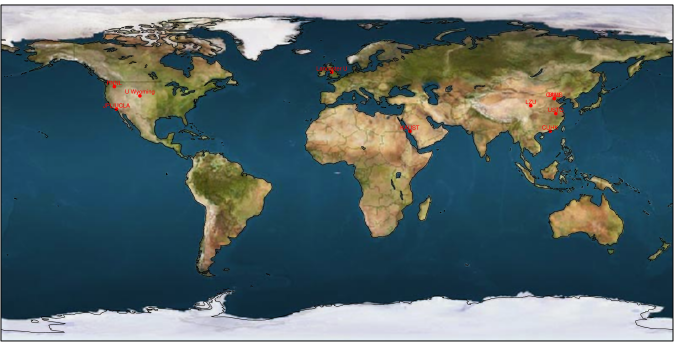Resource list
USTC version of WRF-Chem (USTC-WRF-Chem)
WRF-Chem is the Weather Research and Forecasting (WRF) model coupled with Chemistry. The model simulates the emission, transport, mixing, and chemical transformation of trace gases and aerosols simultaneously with the meteorology. The model is used for investigation of regional-scale air quality, field program analysis, and cloud-scale interactions between clouds and chemistry. The official WRF-Chem web page is located at the NOAA website.
The USTC version of WRF-Chem includes a few additional features compared to the public version. Some of these feature have been/will be released through the public version.
1. GOCART dust emission schemes coupled with MADE/SORGAM and MOSAIC aerosol modules (Zhao et al., 2010, ACP) (Released since official WRF-Chem v3.5.1)
2. Aerosol SW and LW radiative feedback through RRTMG radiation scheme coupled with MADE/SORGAM and MOSAIC aerosol modules (Zhao et al., 2011, ACP) (Released since official WRF-Chem v3.5.1)
3. Online diagnose aerosol speciated radiative forcing/heating (Zhao et al., 2013, JGR)
4. Aerosol-Snow Albedo effect (Zhao et al., 2014, ACP)
5. Online BVOC calculation through CLM-MEGAN system (Zhao et al., 2016, GMD)
6. Quasi-global WRF-Chem simulation for providing chemical boundaries of regional modelling (Zhao et al., 2013, ACP; Hu et al., 2016)
7. Gravitational settling effect of aerosols in MOSAIC
8. Ice nucleation of aerosols in clouds
9. Convective transport and wet scavenging with KF convective scheme (Zhao et al., 2013, ACP)
MPAS over Asia
The Model for Prediction Across Scales (MPAS) is a collaborative project for developing atmosphere, ocean and other earth-system simulation components for use in climate, regional climate and weather studies. The defining features of MPAS are the unstructured Voronoi meshes and C-grid discretization used as the basis for many of the model components. The unstructured Voronoi meshes, formally Spherical Centriodal Voronoi Tesselations (SCVTs), allow for both quasi-uniform discretization of the sphere and local refinement. The C-grid discretization, where the normal component of velocity on cell edges is prognosed, is especially well-suited for higher-resolution, mesoscale atmosphere and ocean simulations. The land ice model takes advantage of the SCVT-dual mesh, which is a triangular Delaunay tessellation appropriate for use with Finite-Element-based discretizations. The official MPAS web page is located at the github website.
The USTC version of MPAS includes a few addition features compared to the public version. Some of these feature will be released through the public version.
Quasi-global WRF-Chem dataset
The Quasi-global WRF-Chem simulation was conducted with USTC-WRF-Chem. The quasi-global channel configuration with periodic boundary conditions in the zonal direction and 360 × 145 grid cells (180° W-180° E, 67.5° S-77.5° N) was used to perform simulation at 1° horizontal resolution. The MOSAIC (Model for Simulation Aerosol Interactions and Chemistry) aerosol module with eight discrete size bins coupled with the CBM-Z (carbon bond mechanism) photochemical mechanism is selected. All major aerosol components including sulfate, nitrate, ammonium, black carbon (BC), organic matter (OM), sea-salt, mineral dust, and other inorganic matter (OIN) are simulated. The meteorological initial and lateral meridional boundary conditions are derived from the National Center for Environmental Prediction final analysis (NCEP/FNL) data at 1° horizontal resolution and 6 h temporal intervals. The modeled wind components u and v and atmospheric temperature are nudged towards the NCEP/FNL reanalysis data throughout the domain with a nudging timescale of 6 h in all cases. Anthropogenic emissions are obtained from global emission dataset HTAP (Janssens-Maenhout et al., 2015). Biogenic emissions are calculated based on MEGAN v2.1 following Guenther et al. (2012 and Zhao et al. (2016). Biomass burning emissions are obtained from the FINN (Fire INventory from Ncar) (Wiedinmyer et al., 2011) and vertically distributed following the injection heights suggested by Dentener et al. (2006) for the Aerosol Comparison between Observations and Models (AeroCom) project. Sea-salt emission follows Zhao et al. (2013). Dust emission is calculated online following Zhao et al. (2010, 2013). More details about the simulation, evaluation, and dataset can be found in Zhao et al. (2013) and Hu et al. (2016).
Currently, the dataset is available for 2007-2015. The dataset can be used for analysis of global aerosol distribution and transport (e.g., Yu et al., 2015; Evan et al., 2015; Ridley et al., 2016; Kok et al., 2017; Kassianov et al., 2017) and for providing chemical initial and lateral boundaries for regional WRF-Chem experiments (e.g., Fan et al., 2015; Zhao et al., 2014; Zhao et al., 2016).
Collaborators used the resources

资源申请
说明
我们尽量在收到资源申请后3个工作日内答复。
